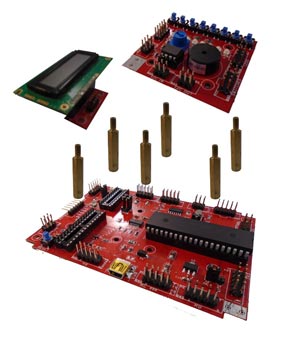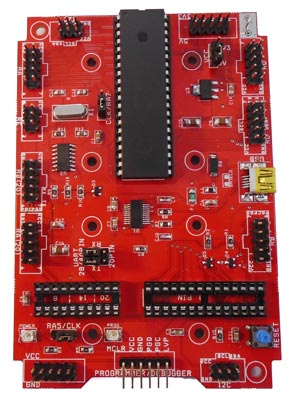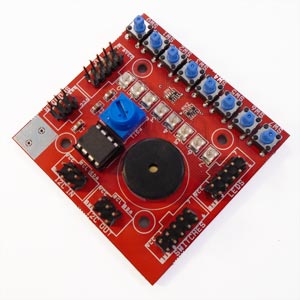Selected Category and Product:
PIC-MICRO-X
Secure Payment by

PIC Microcontroller Programming Kit

- New PIC Kit
- Understand embedded c programming
- Complete kit with modular hardware
- Includes Microchip PICKIT4 debugger and programmer
- Based on Microchip MPLAB X and latest PIC16F1789
- Supports 8,14, 20, 28 pin PIC16F and PIC18F
Shipping to United States
Recorded Airmail: $15.00
Fedex Express: $39.00
Recorded Airmail: $15.00
Fedex Express: $39.00
Order Code
PIC-MICRO-X
PIC-MICRO-X
Price: $169.00
Discontinued
No Replacement
PIC Microcontroller Programming Kit
This PIC kit includes everything you need to learn about PIC microcontroller programming, including, comprehensive HTML tutorials, a book on CD, MPLAB X development software including XC8 C compiler, hardware boards and a PICKit4 programmer and debugger.It is based on one of the new PIC microcontrollers from Microchip, PIC16F1789, which is far better (and cheaper) than older PIC microcontrollers such as PIC16F877. It teaches you PIC microcontroller programming from the beginning and covers all you need to know to build your own projects and learn embedded C programming.
PIC Microcontroller Course
The browser based tutorials, linked to the book and many sample projects, teach you all you need to know about PIC microcontrollers and how to write programs in assembly language and C, using the MPLAB X professional integrated development environment (IDE). You will discover how the PIC microcontroller actually works, which is more work at the beginning but you understand how to be an effective embedded system programmer.The PIC tutorial covers these topics
- PIC Microcontroller layout and structure
- Numbering systems and logic
- Program planning
- How to use MPLAB X IDE properly
- PIC programming in assembly language
- PIC programming in embedded C
- How to download and debug a project
- How to setup and use the PIC microcontroller peripherals
- Discover how to interface UART, LCD, keypads, sensors and much more
- Learn to to re-use code and library files to create a complex project
- Create your own projects
Microchip PICKit4
This PIC kit has a genuine Microchip PICKit4 debugger and programmer. The PICKit3 can just download code to the PIC16F1789 or
be used as an In Circuit Emulator (ICE) to let you debug your code in real time.
A debugger is an essential tool for effective code development, in C or assembler.
PICKit4 can also be run from its own separate software, which makes it ideal for small scale production as you don't
have to use MPLAB X for programming. The PICKit4 can power the target board, therefore no external power supply is required.

Modular Hardware
This PIC kit allows extra modules to be connected to the main board when you need them and a complete, custom, project can be assembled in one simple stack ready to fit into a project box. The training board comes with the kit and this can form part of the final project or be removed.

Extra modules, sensors, keypad, LCD and prototyping boards come with mounting pillars and cables and can simply fitted to the main board or built onto other modules as needed.
PIC Main Board
The main board is compact but has sockets for all 8, 14, 20, 28 and 40-pin PIC microcontrollers, so you can change to a different
device if required. It has a 40-pin PIC16F1789 fitted - see below for the advantages of this device. It has an
8MHz crystal but the PIC16F1789 configuration bytes can be set to run clock at 32MHz. The PIC board has expansion headers for all the port pins and to connect other modules, such as the training board and LCD. It has a USB connector that appears as a virtual serial port on your PC unike most microcontroller boards
that are still fitted with a standard 9-pin serial port. The board can also be powered through this USB connector.
It has I2C bus connectors and 3.3 and 5V power rails.

PIC18F series Microcontrollers
The board also supports PIC18F series microcontrollers as they have the same pin-out as PIC16F. PICKIT4 also supports PIC18F in program and debug mode. There are some PIC18 assembler and C projects on the CD that cover all the basics. See related products for a suitable PIC18F4221 microcontroller.
PIC Training Board
The PIC training board is mounted onto the main board using pillars and ports are connected using ribbon cables to give complete
flexibility. It has 8 switches and LEDS, analog voltage pot, buzzer, serial EEPROM memory socket and I2C bus interfaces. Sample code
in assembler and C covers these features and many more and the tutorials describe them completely.

PIC16F1789 Benefits
This is one of the latest Microchip PIC 40-pin microcontrollers and bears about as much resemblence to the once popular PIC16F877
as a modern car does to the Model-T Ford.
- Faster - up to 32MHz
- More program memory - 32KB of code space, not 8KB
- More SRAM data memory - for more efficient C code
- Lower power consumption and wider voltage range
- More peripherals, protection and brownout features
- AND it is much cheaper
It compares favourably to the AVR range and eats the ATmega328P commonly used by Arduino kits for breakfast.
Modular design
This PIC kit is modular so once you have used the training board to learn PIC microcontroller programming, you can just connect extra modules like a
LCD or keypad or use the prototyping boards to create your own circuits. Kanda sell a range of accessory boards including sensors for gas,
temperature, humidity, soil moisture and many more. Other modules can also be connected so you can create your own project
using the same hardware - the kit that grows with you.
Ordering Information
| Ordering Information | Order Code: PIC-MICRO-X | Price: $169.00 |
| Shipping to United States: | Recorded airmail - $15.00 | Fedex Express - $39.00 |
No Replacement











